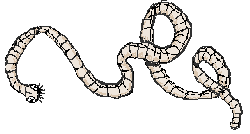Question: Website data re tapeworms seem pretty adamant that tapeworms only come from fleas... How about fecal matter from other animals containing tapeworm segments...? Neighborhood cats visit out yard at nite --- dog takes offense & cleans up next day. Tape worms usually once a year --- no sign of fleas. Is the cat poop a likely source --- or is the only possible source definitely fleas --- meaning we need to forget the cat poop and do a better job of flea control...or...? thanks, Joyce
Answer: Joyce- There are several types of tapeworms that can affect dogs and cats. The method of transmission varies some between the species. The most common tapeworm is Dipylidium caninum. This tapeworm's life cycle starts as an egg passed in the dog or cat's feces. The egg is eaten by a flea or louse and develops into an intermediate stage called a cysticercoid. This is the infective stage. The dog or cat eats the flea which now contains the cysticercoid and becomes infected. The cysticeroid develops into the adult tapeworms and the cycle starts again. There are two other fairly common tapeworms, Taenia pisiformis, which infects dogs and Taenia taenaeformis, which infects cats. Taenia species of tapeworms have a life cycle that involves an intermediate host but it tends to be a small rodent (T. taenaeformis) or lagomorph (rabbit, T. pisiformis). As far as I know, it is necessary to eat the intermediate host to get these tapeworms, as well. Taenia taenaeformis seems to have the name Hydatigera taeniaforms now. There are some Taenia species that can be acquired by eating undercooked meat of goats, sheep and cattle but I don't know how commonly these infect dogs. A much less common tapeworm in domestic dogs is Echinococcus multilocularis. This tapeworm is normally found in wild canine species and is transmitted through an intermediate host, usually a rodent. It is of special concern because if a human ingests the egg of this tapeworm the intermediate host can develop in the human and cause serious disease. This tapeworms isn't a common problem in dogs but it is a serious infection from the standpoint of risk to people. What this means is that the dog is either eating rabbits or eating fleas to get the tapeworms, in all liklihood. Fleas are more likely in most dogs but some dogs are good at hunting rabbits or at finding dead ones to eat. Mike Richards, DVM 7/22/2004
Question: Dear Dr. Richards:
I found some tiny, brownish substances, those are similar to sesame seed in shape but smaller, in my cat beds. They look like organic but I am not sure that my cat excreted them or got stick on his body from somewhere else. I never saw or just did not notice them before. Do you have any idea what they might be? Need I take him to the vet? I just took my cat to the vet today for a small, infected wound he probably got from a fight, and the doctor said he did not have temperature and everything else was fine except that wound. (My cat is about 2.5 - 3 years old.) Sincerely, Thandar
Answer: Thandar-
These sound like tapeworm segments that have dried. We usually say they look like rice granules, but sesame seeds is a good description, too. If you check your cat's stools carefully you might find worm segments that have not dried up. 'These are about 1 to 1.5cm in length and have muscular movement. Over time these dry up. Often they can be found stuck to the hair around the rectum but in cats that groom well you may not ever find a segment on their body, finding them like you did, instead. If you take a couple of these things to your vet he or she should be able to tell you if that is what they are and then give you an appropriate medication, as long as there is a recent weight on file for the cat.
Mike Richards, DVM 6/10/2000
Tapeworms Q: There was a white thing that looked kind of like rice sticking to the hair around my dogs rear and it moved. What is wrong with my dog?
A: What you are seeing is one segment of the tapeworm, which is a specialized muscular egg sac. As it wiggles around it spreads tapeworm eggs. These are eaten by fleas. The dog eats the flea and starts the cycle all over again. The only really effective, safe tapeworm medications are prescription dewormers available from your veterinarian. Praziquantal (Droncit Rx, others) and epsiprantal (Cestex Rx) are the active ingredients that are both safe and effective.
Mike Richards, DVM
Tapeworm
This is the part you see ![]() .
.
Ivermectin and tapeworms Q: We noticed white worms in our dogs stool. As carefully as we observe this dog, we believe it was the first appearance. She is on once-a-month ivermectin heartworm treatments. Shouldn't this have killed those worms?
A: Ivermectin does not kill tapeworms. It is very likely that the worms you are now seeing are tapeworm segments. Your vet can confirm this and prescribe appropriate medications.
Mike Richards, DVMMichael Richards, D.V.M. co-owns a small animal general veterinary practice in rural tidewater Virginia. Dr. Richards graduated from Iowa State University's College of Veterinary Medicine in 1979, and has been in private practice ever since. Dr. Richards has been the director of the PetCare Forum...
